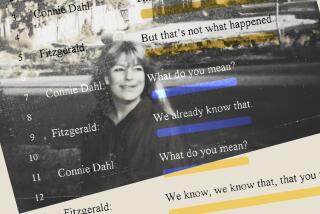Case of the Cavalier ‘Count’ and the Scorned Woman
- Share via
THE COUNT AND THE CONFESSION
A True Mystery
By John Taylor
Random House
366 pages, $24.95
Opposites fascinate. Roger Zygmunt de la Burde, born to a bullying father and suicidal mother in Nazi-occupied Krakow, lived a largely self-fantasized life. In Powhatan County, Va., he pulled enough wool over enough eyes to pass himself off as a wealthy Franco-Polish count of ancient lineage. It didn’t hurt, of course, that he was a renowned art collector and a chivalrous lover to his wife, while keeping his mistresses discreetly on the side. (“European morals,” the locals diagnosed.)
The ever-flamboyant De la Burde could boast some real accomplishments. He amassed real estate assets that could have erased his mounting debts. He adored the art he stole and fenced, and put years into writing a book about it. He was a valued chemist, working in the labs at Philip Morris until he quit in order to launch a potentially lucrative “stolen patent” lawsuit. If Burde often rubbed men the wrong way--”impatient and unrealistic ... suspicious, tightfisted, and easily angered,” according to his own publisher, he could charm women, from his housekeeper-cum-procuratress to the daughters of his girlfriends. For 13 years he enjoyed the love and support of a Southern lady of pedigree and social standing, finally relinquishing his marriage of appearances for the sake of her company. It was this woman, Beverly Monroe, who would be convicted of his murder.
In his account of the 1992 case, “The Count and the Confession,” writer John Taylor displays a respect for facts and for people that his subject, poor, narcissistic Burde, utterly lacked. Each of the carefully sketched portraits in this engrossing tale manages to slide smoothly inside a certain point of view, heightening the tale’s tension through an overall effect of blind single-mindednesses and colliding misapprehensions. Taylor’s self-effacing style permits the story to race ahead in all its garish improbability. Given the complexities of the Monroe case, one wouldn’t be surprised to find an author falling back on that irritating device so popular with nonfiction dramatizers, the “imputed” inner life of characters. But Taylor refrains from fudging: Every thought and emotional response recorded here has a documented ring to it, and the text is nowhere weakened by a rash of “conceivablies,” “probablies” and “almost certainlies.”
The county’s chief investigator, David Riley, who by the end of the day would succeed in eliciting Monroe’s confused and later retracted confession, summed up the case’s tabloidish aspects to his suspect directly, in a confidential tete-a-tete. Riley didn’t blame her, “considering Roger’s abominable behavior and his affairs with Krystyna Drewnowska [a new girlfriend pregnant with Roger’s child at the time of the shooting]....What surprised him, he said, was that she had been able to tolerate the heartless monster for so long. ‘You should get a medal,’ he told her.” A little later Riley emphasized that “the commonwealth attorney ... could paint her as deceitful, manipulative, and vengeful--’a black widow spider ... that killed her mate.’”
Taylor does a nuanced job on the elements of scandal and personal weakness, never allowing this true story to slip into titillating sensationalism. But it is when he lays bare the legal, procedural and institutional scandal and weakness that his work really shines.
By the time the book arrives at its white-knuckle conclusion, the players stand out clearly as either fairly reprehensible (Krystyna, a perjuring witness, possibly Riley), dubious (De la Burde, his daughter Corinna, the defense trial lawyer), or holding fast to the high ground (Beverly’s oldest daughter, her boyfriend, Alan, and perhaps Beverly herself). The police and justice systems come out looking thoroughly tarnished and inadequate--frightening, in fact.
Appearances of official impropriety add up, acts of omission and commission that go well beyond the “one-sidedness” inherent to an adversarial system of law. They range from alleged lies that encourage the confession, and undisclosed and possibly “lost” evidence, to a judge and prosecutor in cahoots to wrap up a first-degree-murder trial in time for their alma mater’s big football game. Whatever the reader’s personal leaning with regard to the question of Monroe’s guilt or innocence--and Taylor does not push his own views on us--one cannot help feeling a frisson of terror at the thought of ever waking up in her predicament.
As her incredulous children gather round, as job and friends, life savings and house melt away, as the press mocks and community ostracizes her, Monroe even in prison keeps her head high. She holds fast to the Southern manners that are her inalienable birthright. In fact, some readers may end up feeling that even if innocent of murdering her lover, Monroe nevertheless bears some guilt in this story--for being a good girl, for having placed far too much trust in the patriarchal society that always promised to look after and defend her, as long as she did what the old boys wanted.
More to Read
Sign up for our Book Club newsletter
Get the latest news, events and more from the Los Angeles Times Book Club, and help us get L.A. reading and talking.
You may occasionally receive promotional content from the Los Angeles Times.






